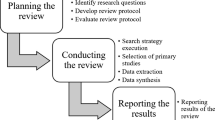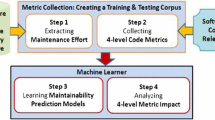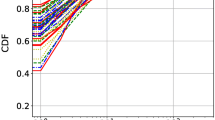Abstract
We develop a quality control and prediction model for improving the quality of software delivered by development to maintenance. This model identifies modules that require priority attention during development and maintenance by using Boolean discriminant functions. The model also predicts during development the quality that will be delivered to maintenance by using both point and confidence interval estimates of quality. We show that it is important to perform a marginal analysis when making a decision about how many metrics to include in a discriminant function. If many metrics are added at once, the contribution of individual metrics is obscured. Also, the marginal analysis provides an effective rule for deciding when to stop adding metrics. We also show that certain metrics are dominant in their effects on classifying quality and that additional metrics are not needed to increase the accuracy of classification. Related to this property of dominance is the property of concordance, which is the degree to which a set of metrics produces the same result in classifying software quality. A high value of concordance implies that additional metrics will not make a significant contribution to accurately classifying quality; hence, these metrics are redundant. Data from the Space Shuttle flight software are used to illustrate the model process.
Similar content being viewed by others
References
Briand, L.C., J. Daly, V. Porter, and J. Wüst (1998), "Predicting Fault-Prone Classes with Design Measures in Object-Oriented Systems," In Proceedings of the Ninth International Symposium on Software Reliability Engineering, IEEE Computer Society Press, Los Alamitos, CA, pp. 334–343.
Conover, W.J. (1971), Practical Nonparametric Statistics, Wiley, New York.
Eman, K.E. (1998), "The Predictive Validity Criterion for Evaluating Binary Classifiers", In Proceedings of the Fifth International Metrics Symposium, IEEE Computer Society Press, Los Alamitos, CA, pp. 235–244.
IEEE Standard for a Software Quality Metrics Methodology (1998), Revision, IEEE Std 1061, IEEE Standards Office, Piscataway, NJ.
Jobson, J.D. (1992), Applied Multivariate Data Analysis, Vol. II, Springer-Verlag, New York.
Khoshgoftaar, T.M. and E.B. Allen (1997), "Logistic Regression Modeling of Software Quality," TRCSE-97-24, Department of Computer Science & Engineering, Florida Atlantic University, Boca Raton, FL.
Khoshgoftaar, T.M. and E.B. Allen (1998), "Predicting the Order of Fault-Prone Modules in Legacy Software," In Proceedings of the Ninth International Symposium on Software Reliability Engineering, IEEE Computer Society Press, Los Alamitos, CA, pp. 344–353.
Khoshgoftaar, T.M., E.B. Allen, R. Halstead, and G. P. Trio (1996a), "Detection of Fault-Prone Software Modules During a Spiral Life Cycle," In Proceedings of the International Conference on Software Maintenance, IEEE Computer Society Press, Los Alamitos, CA, pp. 69–76.
Khoshgoftaar, T.M., E.B. Allen, K. Kalaichelvan, and N. Goel (1996b), "Early Quality Prediction: A Case Study in Telecommunications," IEEE Software, 13, 1, 65–71.
Nikora, A.P. and J.C. Munson (1998), "Determining Fault Insertion Rates for Evolving Software Systems," In Proceedings of the Ninth International Symposium on Software Reliability Engineering, IEEE Computer Society Press, Los Alamitos, CA, pp. 306–315.
Ohlsson, N. and H. Alberg (1996), "Predicting Fault-Prone Software Modules in Telephone Switches," IEEE Transactions on Software Engineering, 22, 12, 886–894.
Porter, A.A. and R.W. Selby (1990), "Empirically Guided Software Development Using Metric-Based Classification Trees," IEEE Software, 7, 2, 46–54.
Schneidewind, N.F. (1992), "Methodology for Validating Software Metrics," IEEE Transactions on Software Engineering, 18, 5, 410–422.
Schneidewind, N.F. (1995), "Work in Progress Report: Experiment in Including Metrics in a Software Reliability Model," In Proceedings of the Annual Oregon Workshop on Software Metrics, Portland State University, Portland, OR, 17 pages.
Schneidewind, N.F. (1997a), "Software Metrics Model for Quality Control," In Proceedings of the International Metrics Symposium, IEEE Computer Society Press, Los Alamitos, CA, pp. 127–136.
Schneidewind, N.F. (1997b), "Software Metrics Model for Integrating Quality Control and Prediction," In Proceedings of the International Symposium on Software Reliability Engineering, IEEE Computer Society Press, Los Alamitos, CA, pp. 402–415.
Author information
Authors and Affiliations
Rights and permissions
About this article
Cite this article
Schneidewind, N.F. Software quality control and prediction model for maintenance. Annals of Software Engineering 9, 79–101 (2000). https://doi.org/10.1023/A:1018920623712
Issue Date:
DOI: https://doi.org/10.1023/A:1018920623712




